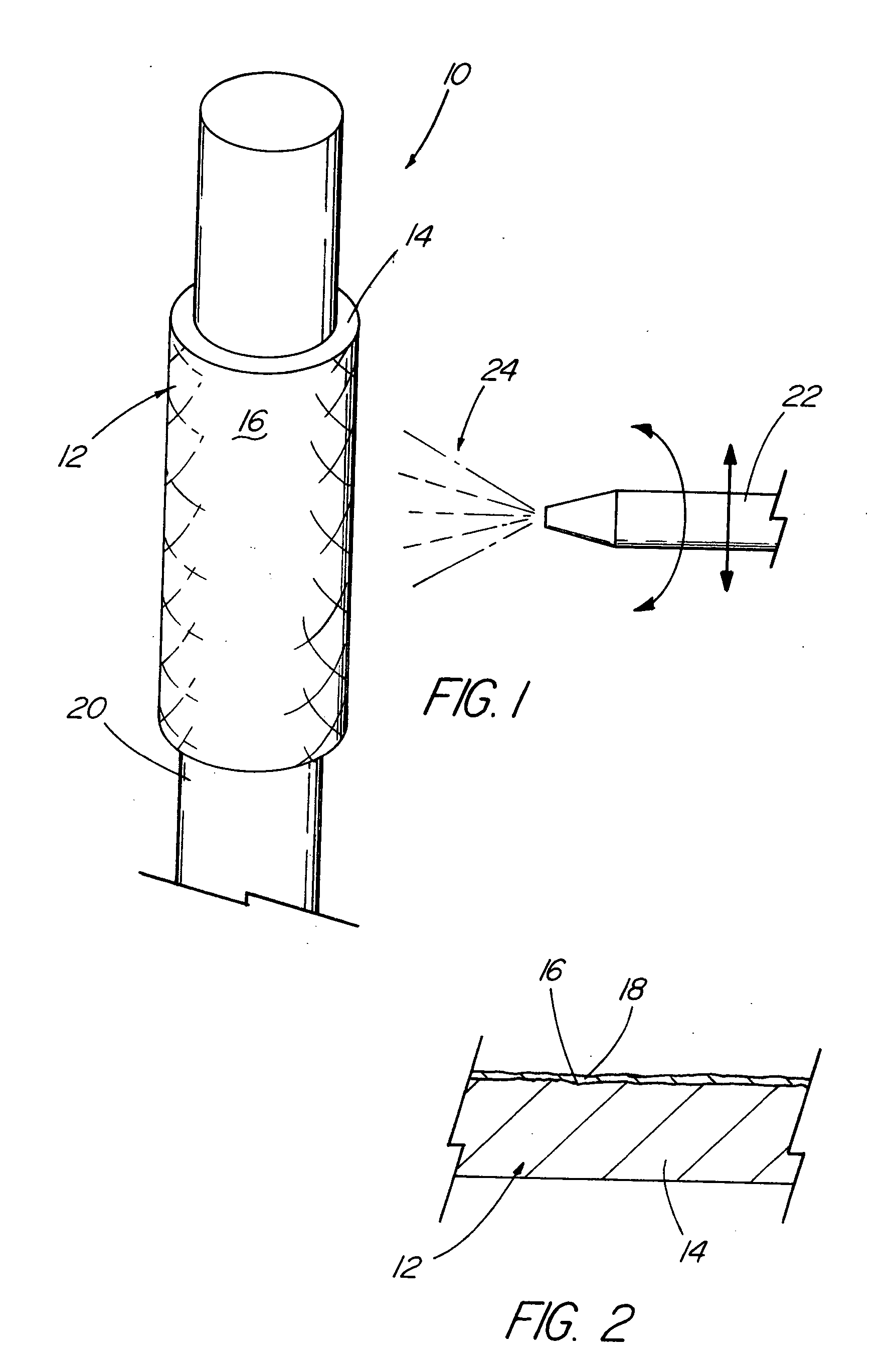[0015] The foregoing problems are solved and a technical advance is achieved in an illustrative embodiment of a coated medical device of the present invention in which a
drug, therapeutic agent,
diagnostic agent or other bioactive or pharmacologically active material is delivered or applied directly to the surface of the passage or vessel wall. In one illustrative embodiment, the coated medical device comprises an expandable balloon of which a bioactive material is applied thereto and coats the outer surface of the expandable balloon. In a preferred illustrative embodiment, the bioactive material is a lipophilic material such as
paclitaxel or dexamethazone which is an anti-inflammatory
steroid for attachment to the
cell wall. This lipophilic bioactive material is attracted by the
cell membrane of the endothelial cells of the inner wall and initially adheres to these cells when put in contact therewith. The lipophilic material is then drawn or transferred into the
cell membrane. In addition, when the endothelial cells are injured or removed from the inner wall,
smooth muscle cells are then exposed which also include lipids and attract the lipophilic bioactive material. The delivery and / or attachment of this lipophilic bioactive material is preferably accomplished by bringing the lipophilic bioactive material in physical or direct contact with the endothelial or
smooth muscle cells. Thus, the medical device of the present invention not only includes preferably an expandable balloon but an expandable balloon with a
coating of the preferred lipophilic bioactive material. When the balloon is expanded at the treatment site, the
coating material and, in particular, the lipophilic bioactive material is brought into direct or physical contact with the inner wall cells of the vessel and thus transferred from the balloon to the desired passage or vessel wall cells. When transferring the preferred lipophilic bioactive material to the vessel wall, preferred inflation times of up to and about one minute are used in delivering the lipophilic bioactive material. To further improve the treatment of the vessel wall and transfer the bioactive material thereto, a hydrophilic material is applied to the base material of the device of which the preferred lipophilic bioactive material is applied or coated thereon. This hydrophilic material, also known as a slip
coating lessens the adhesion of the base material to the lipophilic bioactive material and helps facilitate a delivery of the lipophilic material to the vessel cells at the delivery site. In addition, blood for example, helps wet the slip coating and further enhance the delivery process and deliver as much of the lipophilic bioactive material to the vessel wall. Thus, by selecting the ratio of lipophilic to
hydrophilic coating materials, the delivery of the lipophilic material to the vessel walls can be better controlled. This ratio can be altered depending on the particular type of base material of the delivery device and the particular bioactive material being delivered to the vessel wall.
[0019] As described in more detail below, the base material of the structure and the bioactive material posited on that base material can comprise any of a wide range of suitable materials. The selection of a specific combination of base material, bioactive material and
surface roughness or texture depends upon the intended use of the medical device. Although texture may have a meaning of a repeatable pattern, this is clearly not the intent. The surface of the stent is that of any
topography, whether repeatable or not, that helps improve adhesion of the bioactive material on the base material or modification thereof. Hereinafter, a textured surface will include a roughened, uneven, or unsmooth surface. The suitability of a chosen combination can readily be determined by an adhesion test which simulates the actual delivery of bioactive material during introduction and deployment of the device in a patient. Such a test is straightforward and is believed not to entail an undue amount of experimentation, particularly in comparison to the amount and technical level of testing required before a product of this type can be marketed in the United States.
[0020] The medical device of the present invention and its method of manufacture have several advantages over prior stents and other medical devices and methods for manufacturing them. The time and cost of manufacture of the medical device are minimized by the absence of any steps to incorporate the bioactive material in a containment layer, or to apply a containment or time-release layer over the bioactive material. The particularly preferred use of
sodium bicarbonate as the
abrasive to treat, roughen, or texture the surface of the base material of the structure enjoys several indirect
cost savings resulting from the
low toxicity of the
sodium bicarbonate to production workers, the ease of product and waste cleanup, and the
biocompatibility of any residual
sodium bicarbonate. Worker safety and ease of product and waste cleanup are, of course, important advantages in their own right.
[0033] Again, as indicated above, the medical device of the present invention and its method of manufacture have several advantages over prior stents and other medical devices and methods for manufacturing them. The time and cost of manufacture of the medical device of the present invention are minimized by the absence of any steps to incorporate the bioactive material in a containment layer, or to apply a containment or time-release layer over the bioactive material. The particularly preferred use of
sodium bicarbonate as the
abrasive to roughen or texture the surface of the base material of the structure enjoys
cost savings resulting from the
low toxicity of the
sodium bicarbonate to production workers, the ease of product and waste cleanup, and the
biocompatibility of any residual
sodium bicarbonate. It should go without saying that the good worker safety and ease of product and waste cleanup enjoyed by the method of the present invention are highly desirable advantages, without regard to any costs saved.
 Login to View More
Login to View More 


